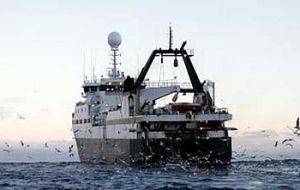MercoPress. South Atlantic News Agency
Norway developing eco-friendly trawl technology
 An eco-friendly trawler at sea. <br>(Photo: Aker Biomarine)
An eco-friendly trawler at sea. <br>(Photo: Aker Biomarine) The Norwegian fisheries magnate Kjell Inge Røkke and the industry have lately spent around NOK 10 million (EUR 1.25 million) on developing eco-friendlier trawls. One trawler operating off the West coast of Norway and a shrimp trawler fishing in the Oslo fjord in Eastern Norway are helping to develop the new trawl technology.
According to the Norwegian press, one unnamed marine scientist been recruited to assist in the development of the technology. Through the company Aker Biomarine, Røkke funded the development of a technology in which krill is pumped directly from the trawl to the vessel factory. A hose goes from the vessel down to the trawl. Through a small hose, air is pumped down and mixed in with the catch. The air then pushes the catch up through the pipe. The system has revolutionized krill fishing. Røkke is now aiming to develop a trawling system that is more selective in terms of what is kept and what parts of the catch should be released unharmed through the assistance of electronic devices. Today, the global fishing fleet kills millions of tonnes of unwanted by-catch by emptying the trawl on the deck and throwing back the unwanted catch - often already dead - to the sea. The new technology will reduce by-catch, and then apply the system used for air pumping krill in fish and shrimp trawling. Although it has not yet been mentioned in the reports, if pelagic trawlers pump the catch directly from the trawl net this will reduce fuel consumption substantially. A pelagic trawler today has to empty the trawl net every time the catch is large enough or trawling for a maximum period of time. The new technology will allow trawlers to operate non-stop until the desired volume has been caught. This will save both fuel and time. If successfully developed, the selection process will prove valuable for bottom fish trawlers looking to automatically release small fish unharmed. Today the trawlers either discontinue fishing if they are catching too many undersized fish, or throw the by-catch back to the sea. The new technology is also supposed to identify both the size and species of the fish yet nothing is known on how this can be done. By identifying the mix of species, it is possible to optimise fishing. For example, as different schools of species are identified, which often swim at different heights from the sea floor, trawl fishing can target different schools depending on the height from the sea bottom. If a sensitivity to the right size is added to this, trawl fishing may become highly eco-friendly if Røkke succeeds. The trials and development of the new system are expected to take at least a couple of years. (FIS).-




Top Comments
Disclaimer & comment rulesCommenting for this story is now closed.
If you have a Facebook account, become a fan and comment on our Facebook Page!